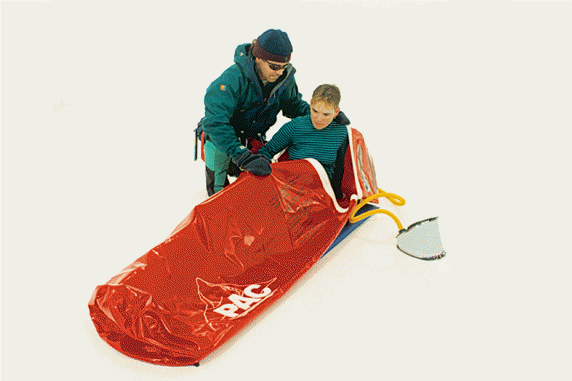Altitude
chambers  are
used to treat severe Acute mountain Sickness, and works especially
well for the severe persistent headache at altitude. It is especially
useful for the treatment of Cerebral Edema. The treatment of choice for
pulmonary edema is oxygen and decent, but if this is immediately
impractical then the gamow bag can be used to buy time. are
used to treat severe Acute mountain Sickness, and works especially
well for the severe persistent headache at altitude. It is especially
useful for the treatment of Cerebral Edema. The treatment of choice for
pulmonary edema is oxygen and decent, but if this is immediately
impractical then the gamow bag can be used to buy time.
The pressure
chamber concept has been around for 20 years or more, yet the majority
of independent mountaineers going to high altitudes do so without this
essential piece of safety equipment. The PAC and Gamow bags are kept at
the HRA (Himalayan Rescue Associations locations and Peak Freaks keeps
one in our expedition kit at base camp.
The bags/chambers are an
answer to the need for an effective, simple, durable, lightweight and
affordable pressure chamber for the treatment of AMS.
Effective
The technology has been shown to be highly effective in the
reversal of symptoms of AMS. Depending on the starting altitude,
simulated descents of about 2000 meters (6000 feet) are achieved at the
operating pressure of 2 PSI above ambient pressure.
The individual should be
pressurized in the bag for one to two hours and then reassessed some 12
hours later for father treatment. Consult the manual for details about
use. individuals going into the bag should also receive appropriate
medication. For example, if the climber is vomiting or nauseous, then
they should receive appropriate medication. For example, if the climber
is vomiting or nauseous, then they should receive intramuscularly gravol
before going into the closed confined space of the bag. Close contact
would be maintained with the individual as the bag is very
claustrophobic.
Acute Mountain
Sickness (AMS)
As we ascend above 2500 metres (8000 feet) our bodies must acclimatize
to the decreasing amount of oxygen available. Failure to acclimatize can
result in AMS.
The symptoms of AMS may include any of the following: headache, fatigue,
loss of appetite, shortness of breath, cough, dizziness, blurred vision,
vomiting, etc. The intensity and severity of these symptoms will vary,
but can very quickly become extremely serious and even fatal.
The only treatment for
AMS is to descend to a lower altitude.
However, there are many
situations where immediate descent is difficult if not impossible, due
to the hazards of weather, lack of manpower, difficult terrain or
geography such as a plateau.
PAC technology buys
time and can stabilize or reverse severe symptoms of AMS before (or
while) descent is undertaken.
|